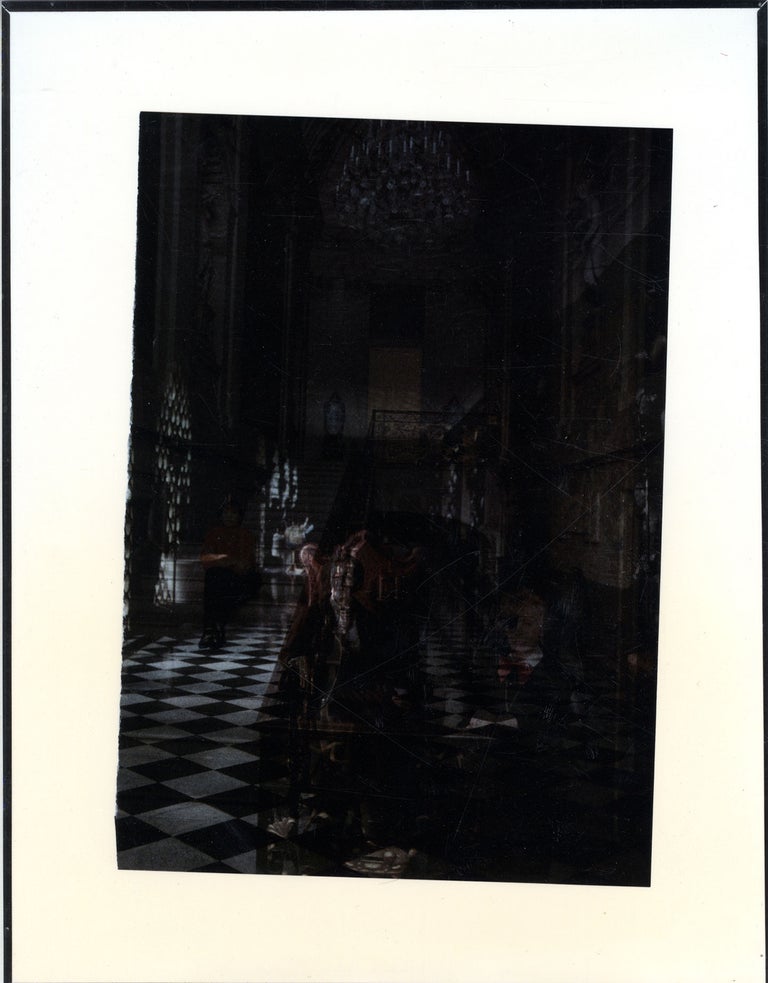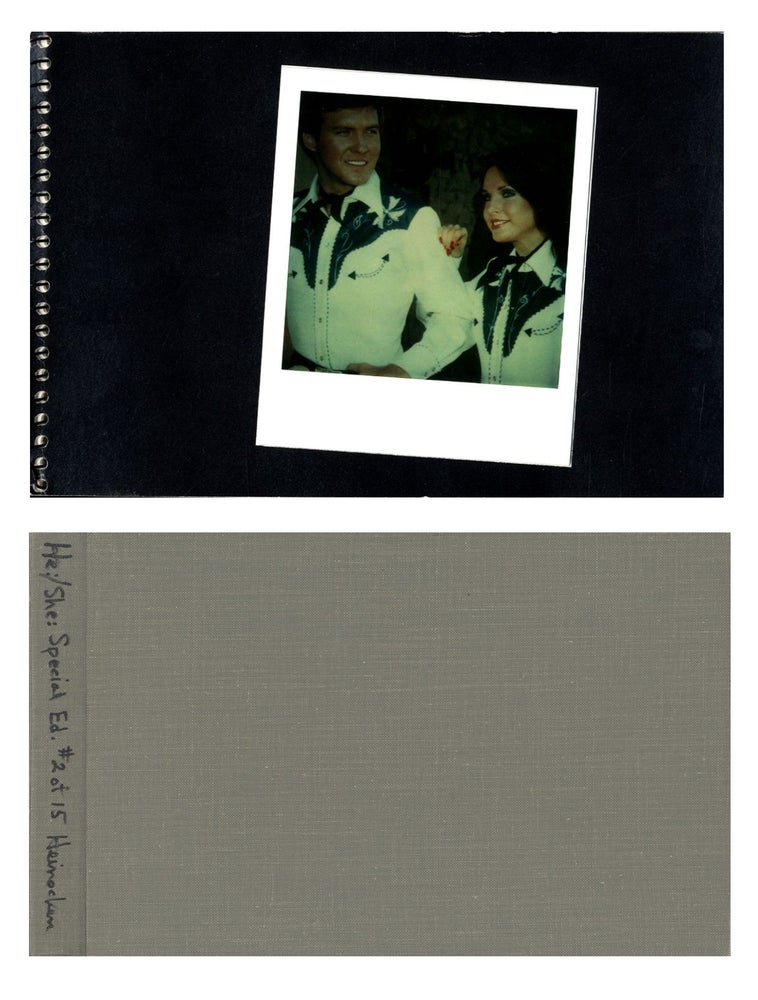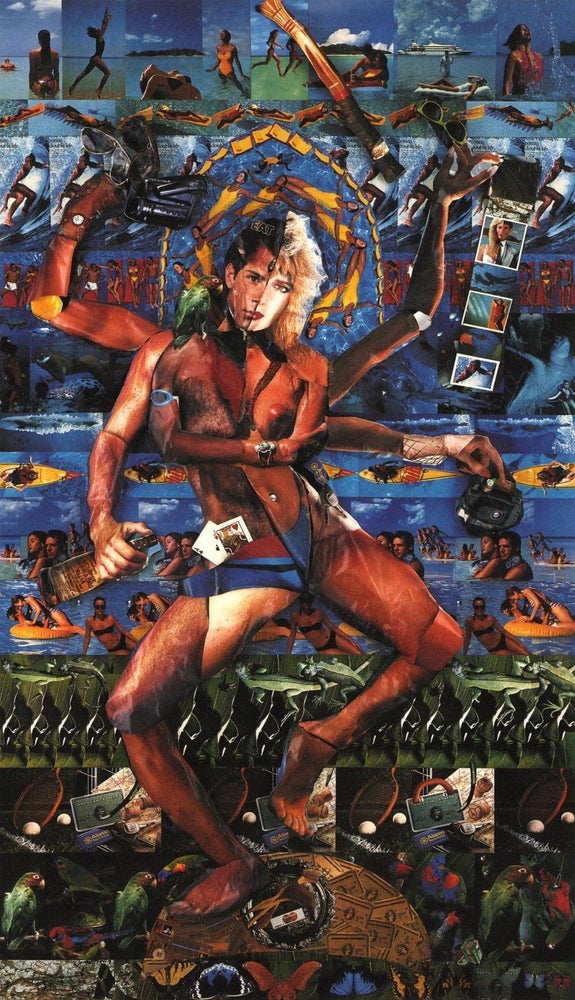Robert Heinecken: ...wore khakis, Limited Edition (Hand-Made Proof) [SIGNED]
Publisher: Los Angeles: Robert Heinecken (Self-published), with Nazraeli Press, Portland, Oregon, 1999
Edition: 1st Edition
Binding: Hardcover
Condition: New / No dust jacket as issued
Item #: 102295
$10,000.00
Specifics
First edition, first printing. Limited edition of 20 individually hand-made proof copies (not officially published), numbered and signed in black ink on the title page by Heinecken, and stamped "FIRST PROOF" in black ink on the title page.
Hardcover. White archival matte boards with title printed in black on matte white paper pasted to the front and back boards; white spiral binding; contained in a fine khaki cloth-covered clamshell box with the title stamped in black on the front and back. Includes an essay by David Pagel and a bibliography of works. Unpaginated (60 pp.), with 56 black and white printer's proofs (black and white "plates"), each meticulously hand-cut by the artist revealing multiple layers of selected sections of Gap ads in subsequent sheets. The book is 10-1/2 x 8-5/8 inches; the clamshell box measures 11-5/8 x 9-1/4 inches.
[Cited in Martin Parr and Gerry Badger, The Photobook: A History, Volume III. (London and New York: Phaidon, 2014)].
Condition
New (from the artist's archive).
Description
One of the very best artist's books I've ever seen! The resulting numerous "collages," in some cases 4 or 5 pages deep, are nothing short of brilliant. This extraordinary artist's book is a meticulously constructed succession of altered GAP clothing print advertisements from the 1990s that featured vintage, mostly 1940s-50s photographs of celebrities wearing khaki pants. One of Heinecken's most brilliant working methods--cutting out images from mass-media publications in order to reveal the complex layering and disintegration of meaning that occurs when the reader turns each page and can literally see beyond the surface--returns here in what amounts to a virtuoso artistic performance.
As critic David Pagel writes in his essay The Gaps in the Ads: Robert Heinecken's Sabotaged GAP Ads, "Armed with only an X-Acto knife and stacks of GAP ads torn from everyday magazines, Heinecken hunkered down in a cramped little studio over a two-car garage in the Hollywood Hills and single-handedly turned a multi-million dollar advertising campaign on its ear... Using nothing but his wits and a blade he got the GAP ads to tell stories that were radically different from the ones they were supposed to tell. Working with what was available to any citizen with open eyes and a sharp mind, Heinecken twisted the corporate images so that they'd send mixed messages and implicate viewers by getting us actively involved in ways that were neither intended by the originals nor anticipated by us... Heinecken [creates] a sequence of images in which one celebrity always intrudes into another's ad.
On each subsequent page, the previous page's intruder is likewise intruded upon by another celebrity... In Heinecken's hands, barbed, do-it-yourself humor displaces the bland, homogenized illusions served up by the advertising industry. It's frankly hilarious to see Steve McQueen looking us in the eye and holding up his hand as if to say, 'Don't pay attention to Sammy Davis Jr. dancing behind me, I've got something really important to tell you.' [The book's final plate], the picture of Heinecken wearing his United States Marine Corps fighter pilot khaki flight suit, quietly links the GAP advertising campaign to military campaigns... Combining advertising's seductive attractions with an unsettling edginess that's all the more potent because you don't know what it's selling, Heinecken's GAP project embodies the confidence that ordinary ads can be used against their own purposes--for ends that are liberating precisely because they are neither prescribed nor clearly defined, but disruptive, optimistic, and unanticipated."
About Robert Heinecken:
Robert Heinecken is one of the most innovative and influential artists of the second half of the 20th century. He was a pioneer of postmodern photographic practices, and his work anticipated the Pictures Generation artists of the 1970s and 1980s who practiced the appropriation of images from advertising and the media. A self-described “para-photographer,” Heinecken was always challenging the conventions of the then-accepted “canon” of photography. He transformed the possibilities of the medium, and had a profound impact on many photography-based artists who studied with him.
Influenced by Dada and Surrealism, especially Marcel Duchamp, Man Ray and John Heartfield, Heinecken worked with numerous photographic techniques and materials, oftentimes combining them with various printmaking processes. In addition to offset lithography and etching, he made use of film transparencies, photographic emulsion on canvas, gelatin silver prints mounted to wood (e.g., "Multiple Solution Puzzle" Series), Polaroid materials, mixed media collage and photograms (e.g., ARE YOU REA and Recto/Verso Series).
His source materials included popular “lifestyle” magazines, advertising, images taken directly from television screens, pornography and news photographs. Through his ground-breaking works, Heinecken transformed American notions of consumerism, war, eroticism and mass media.
From Robert Heinecken (in the mid-1960s): "We constantly tend to misuse or misunderstand the term reality in reference to photographs. The photograph itself is the only thing that is real, that exists... (There is a vast difference between taking a picture and making a photograph.)."
An excerpt from a text written by Carl Chiarenza (in 1976): "He uses existing photographs... and their reproductions because they have littered the world and our minds with unlimited examples of every conceivable image of truth, beauty, banality, eroticism, brutality, pornography, consumerism, political idea, personality, idol, and ideal. Indeed one is hard put to name anything that has not been replaced by a photographically derived image. His recycling of these images makes this astounding point before making any other. Heinecken knows the photograph is not real. He also knows that most of us still believe it is... The camera eye is lusty and insatiable, a perfect match for Heinecken's eye."
Robert Heinecken was born in 1931 in Denver, Colorado and in 1942 his family relocated to Riverside, California. After serving in the US Marine Corps, he earned a BA in 1959 from the University of California, Los Angeles, where he continued his studies, specializing in printmaking and graduating with an MFA in 1960. He founded the graduate program for photography at UCLA in 1964, where he taught until 1991. Heinecken died at age 74 in 2006 in Albuquerque, New Mexico.


![Robert Heinecken: ...wore khakis, Limited Edition (Hand-Made Proof) [SIGNED]](https://vincentborrelli.cdn.bibliopolis.com/pictures/102295.jpg?auto=webp&v=1416426310)
![Robert Heinecken: ...wore khakis, Limited Edition (Hand-Made Proof) [SIGNED]](https://vincentborrelli.cdn.bibliopolis.com/pictures/102295_2.jpg?auto=webp&v=1416426312)
![Robert Heinecken: ...wore khakis, Limited Edition (Hand-Made Proof) [SIGNED]](https://vincentborrelli.cdn.bibliopolis.com/pictures/102295_3.jpg?auto=webp&v=1416426313)
![Robert Heinecken: ...wore khakis, Limited Edition (Hand-Made Proof) [SIGNED]](https://vincentborrelli.cdn.bibliopolis.com/pictures/102295_4.jpg?auto=webp&v=1416426315)
![Robert Heinecken: ...wore khakis, Limited Edition (Hand-Made Proof) [SIGNED]](https://vincentborrelli.cdn.bibliopolis.com/pictures/102295_5.jpg?auto=webp&v=1416426316)
![Robert Heinecken: ...wore khakis, Limited Edition (Hand-Made Proof) [SIGNED]](https://vincentborrelli.cdn.bibliopolis.com/pictures/102295_6.jpg?auto=webp&v=1416426317)
![Robert Heinecken: ...wore khakis, Limited Edition (Hand-Made Proof) [SIGNED]](https://vincentborrelli.cdn.bibliopolis.com/pictures/102295_7.jpg?auto=webp&v=1416426319)
![Robert Heinecken: ...wore khakis, Limited Edition (Hand-Made Proof) [SIGNED]](https://vincentborrelli.cdn.bibliopolis.com/pictures/102295_8.jpg?auto=webp&v=1702147159)
![Robert Heinecken: ...wore khakis, Limited Edition (Hand-Made Proof) [SIGNED]](https://vincentborrelli.cdn.bibliopolis.com/pictures/102295_9.jpg?auto=webp&v=1702147159)
![Robert Heinecken: ...wore khakis, Limited Edition (Hand-Made Proof) [SIGNED]](https://vincentborrelli.cdn.bibliopolis.com/pictures/102295_10.jpg?auto=webp&v=1702147159)
![Robert Heinecken: ...wore khakis, Limited Edition (Hand-Made Proof) [SIGNED]](https://vincentborrelli.cdn.bibliopolis.com/pictures/102295_12.jpg?auto=webp&v=1702147159)
![Robert Heinecken: ...wore khakis, Limited Edition (Hand-Made Proof) [SIGNED]](https://vincentborrelli.cdn.bibliopolis.com/pictures/102295_13.jpg?auto=webp&v=1702147159)
![Robert Heinecken: ...wore khakis, Limited Edition (Hand-Made Proof) [SIGNED]](https://vincentborrelli.cdn.bibliopolis.com/pictures/102295_14.jpg?auto=webp&v=1702147159)
![Robert Heinecken: ...wore khakis, Limited Edition (Hand-Made Proof) [SIGNED]](https://vincentborrelli.cdn.bibliopolis.com/pictures/102295_15.jpg?auto=webp&v=1702147159)
![Robert Heinecken: ...wore khakis, Limited Edition (Hand-Made Proof) [SIGNED]](https://vincentborrelli.cdn.bibliopolis.com/pictures/102295_16.jpg?auto=webp&v=1702147159)
![Robert Heinecken: ...wore khakis, Limited Edition (Hand-Made Proof) [SIGNED]](https://vincentborrelli.cdn.bibliopolis.com/pictures/102295_17.jpg?auto=webp&v=1702147159)
![Robert Heinecken: ...wore khakis, Limited Edition (Hand-Made Proof) [SIGNED]](https://vincentborrelli.cdn.bibliopolis.com/pictures/102295_18.jpg?auto=webp&v=1702147159)
![Robert Heinecken: ...wore khakis, Limited Edition (Hand-Made Proof) [SIGNED]](https://vincentborrelli.cdn.bibliopolis.com/pictures/102295_19.jpg?auto=webp&v=1702147159)
![Robert Heinecken: ...wore khakis, Limited Edition (Hand-Made Proof) [SIGNED]](https://vincentborrelli.cdn.bibliopolis.com/pictures/102295_20.jpg?auto=webp&v=1702147159)
![Robert Heinecken: ...wore khakis, Limited Edition (Hand-Made Proof) [SIGNED]](https://vincentborrelli.cdn.bibliopolis.com/pictures/102295_21.jpg?auto=webp&v=1702147158)
![Robert Heinecken: ...wore khakis, Limited Edition (Hand-Made Proof) [SIGNED]](https://vincentborrelli.cdn.bibliopolis.com/pictures/102295_22.jpg?auto=webp&v=1702147158)


